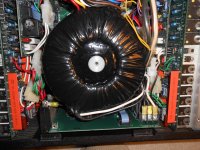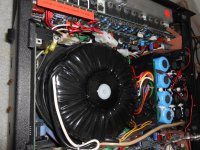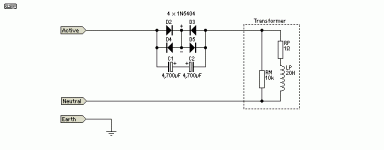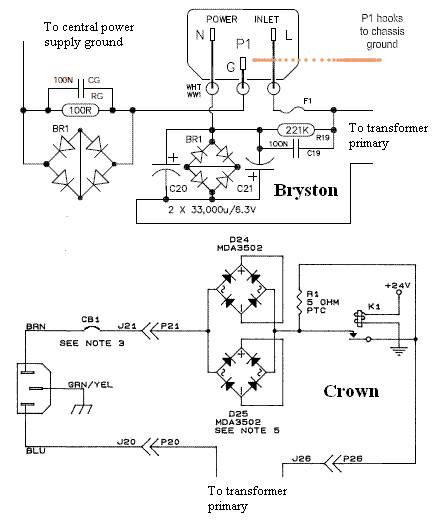Still trying to tame my Crest CA-18 for home theatre use. I have read all the other threads regarding Toroid noise. I am convinced that the noise is caused by DC on the AC line. Noise increases when a Micro wave is used although they are on separate breakers.
I have been directed to DC blocking circuits for the AC line, but that amp calls for a 30 amp circuit. I have received a lot of guidance from everyone here so far, but could someone help me with determining cap and diode values and ratings to handle this amp. It will be driving two 1500 Watt RCF 18" woofers that I want to "beat the heck out of". Would the caps not have to be of impractical size, not to impede the amp's performance?
As mentioned, my Yamaha P2200 with toroid, on the same circuit, makes no noise. Stethascope examination seems to show me that the noise is coming from the windings and not the centre of the trans or outside ferite shielding or even cabinet resonance. The windings seem to be only wrapped in non adhesive plastic tape. I am very tempted to partially removing the tape and soaking the trans in varathane. Has anyone had success reducing toroid noise, post production?
I have been directed to DC blocking circuits for the AC line, but that amp calls for a 30 amp circuit. I have received a lot of guidance from everyone here so far, but could someone help me with determining cap and diode values and ratings to handle this amp. It will be driving two 1500 Watt RCF 18" woofers that I want to "beat the heck out of". Would the caps not have to be of impractical size, not to impede the amp's performance?
As mentioned, my Yamaha P2200 with toroid, on the same circuit, makes no noise. Stethascope examination seems to show me that the noise is coming from the windings and not the centre of the trans or outside ferite shielding or even cabinet resonance. The windings seem to be only wrapped in non adhesive plastic tape. I am very tempted to partially removing the tape and soaking the trans in varathane. Has anyone had success reducing toroid noise, post production?
Attachments
I don't think soaking will fully cure your transformer noise - DC on the power line is a very difficult thing to cure unless you take specific measures - See Rod Elliot for an expose on the subject. I would do some basic tests to confirm your hypothesis. The problem gets worse the BIGGER the transformer. While I lived in Taiwan, I had a problem with the washing machine that caused the power transformers in my otherwise silent e-Amp and the Ovation 250 to buzz like a chain saw.
Since the capacitors will be clamped by a diode bridge, you do not need high voltage devices - 16V should be ok and if you can get lower even better - the main thing you need to worry about is the ripple current. I would suggest something between 15000 to 22000 uF.
Since the capacitors will be clamped by a diode bridge, you do not need high voltage devices - 16V should be ok and if you can get lower even better - the main thing you need to worry about is the ripple current. I would suggest something between 15000 to 22000 uF.
More the better, yes. The caps can be low voltage such as 16 volt or even 6.3 volt working. Look for high ripple current ratings for the caps. The diodes should never really come into play, they simply clamp the voltage across the caps to 1.2 volts (two diode volt drops). A 400 volt 20 or 30 amp bridge is cheap and very convenient to wire for this type of thing as you will see you are simply linking the bridge - and + connections together and placing the caps (which are in series) across the AC input to the bridge.
Edit... the caps should be identical types whatever you choose.
Edit... the caps should be identical types whatever you choose.
Hi mlloyd1,
I re-read Mr. Elliot's note and he recommended the series connection, as the parallel design was untested.
I have recently bought electrolytics for an amplifier power supply, but the only spec re current was a mention of 'high ripple current'. The amp will draw 36 amps if driving 4 ohms bridged (5000 Watts). It has a max output of 1000 watts per ch. into 8 ohms. I have changed the line cord plug to a conventional 120 VAC plug, and do not expect to trip the 15 amp breaker dedicated to the amp. I'm crazy but not that crazy. What are typical ripple current ratings for caps this size, and do I need a bank of them?
Also, with reverse parallel hook-up, wouldn't the cap leakage tend to offset the DC blocking effect?
Thanks again, Peter
I re-read Mr. Elliot's note and he recommended the series connection, as the parallel design was untested.
I have recently bought electrolytics for an amplifier power supply, but the only spec re current was a mention of 'high ripple current'. The amp will draw 36 amps if driving 4 ohms bridged (5000 Watts). It has a max output of 1000 watts per ch. into 8 ohms. I have changed the line cord plug to a conventional 120 VAC plug, and do not expect to trip the 15 amp breaker dedicated to the amp. I'm crazy but not that crazy. What are typical ripple current ratings for caps this size, and do I need a bank of them?
Also, with reverse parallel hook-up, wouldn't the cap leakage tend to offset the DC blocking effect?
Thanks again, Peter
The caps in the power supply are NOT sized to handle the full ripple current that the amplifier can produce. Almost none do. They are designed for typical loading, which is 1/3 power in 4 ohms for this type of amplifier. Think about it. You put out 5000 watts continuously and your ears are bleeding and there's smoke pouring out of your RCFs. You don't need caps rated for 36A, probably 12-18 A is fine. I would still use large computer grade units in series-parallel. Low voltage units (under 50V) can be had on the surplus market for cheap - the high voltage ones suitable for building amps come at a premium  . Mount the caps (and heat sinked rectifier) inside a FULLY ENCLOSED, UL LISTED metal enclosure near your panel. And only feed your dedicated outlet off of it. I do this for line filters feeding home server farms or equpiment being operated off a permanently installed transformer.
. Mount the caps (and heat sinked rectifier) inside a FULLY ENCLOSED, UL LISTED metal enclosure near your panel. And only feed your dedicated outlet off of it. I do this for line filters feeding home server farms or equpiment being operated off a permanently installed transformer.
If you are worried about the ripple currents, just parallel the caps.
Stop agonizing and just do it. Absolute worst case scenario? The caps get hot and swell up but everything is ok because the diode bridge is in situ.
I seriously doubt you will need 5000 W of bass power.
It's good advice to locate the DC blocker in a separate housing. Don't dick with your amps.

Stop agonizing and just do it. Absolute worst case scenario? The caps get hot and swell up but everything is ok because the diode bridge is in situ.
I seriously doubt you will need 5000 W of bass power.
It's good advice to locate the DC blocker in a separate housing. Don't dick with your amps.
Last edited:
Remove the sketchy Torroid.
There's nothing sketchy about that toriod. It's a 2.5kVA. At that power level THEY ALL DO THAT. It will be quieter if you keep DC off the line, but no transformer in that power class is absolutely silent. It's possible for a large multi-kVA toroid to run quiet, but you have to back off on the primary voltage to do it (ie, run a 240V primary at 120V resulting in half the rated kVA). Buy a very very VERY expensive amplifier and that's exactly what they do.
Amplifiers like this actually make quite a bit of noise in operation. Try hooking one up with a dummy load (water heater element in a bucket of ice water) and playing music through it at full volume. You'll hear a lot of sound coming off the amp. Not just from the fans or transformer. These amps are intended to be installed in projection rooms or up on stage behind a big stack of very loud speakers. Being absolutely silent was not a design parameter. You could get similar power (and a whole lot of heat) out of a pair of bridged Krells. That will set you back a few k. The transformers will be quieter for the reasons stated above - but if you get DC on the line you'll still hear them.
The amplifier's current comes from the capacitors in the smoothing bank and the local supply rail decoupling.I really feel that anything in series with the line, might take away some of this monster amp's 'punch'. However, a DC blocking circuit may be less of a destructive test than my 'dipping' idea.
The rectifier is OFF for about 90% of the time that the amplifier is ON.
The mains recharges the partially depleted capacitors during the short (~10%) ON time of the rectifier.
The mains supply has no effect on the transient current through the amplifier.
I had the transformer for my Ovation 250 wound by Airlink in the UK. It cost me over GBP 300. It's rated at 1 kVA and weights 18 kg. It is absolutely silent. I told them it was for audio - they used a special core material and the centre is filled with epoxy, rest of the thing covered in expose resin.
DC blocker from ATL
Trust me, the best DC blocker I know is from ATL. PCB, PCB assembled or assembled in case:
-> al_tsankov | eBay
Assembled in case:
Trust me, the best DC blocker I know is from ATL. PCB, PCB assembled or assembled in case:
-> al_tsankov | eBay
An externally hosted image should be here but it was not working when we last tested it.
Assembled in case:
I have some of they. I prefer the "maty edition box", with slow fuse, varistor and... EPCOS 18000 microF 105ºC.DC Blocker is built with following parts:
- 15 000 uF EPCOS capacitors
- high-voltage diodes HER605
- 10W power resistor
- WIMA MKS4 400VAC capacitor
- MOLEX 3-terminal connectors for AC input/output
- Schurter IEC power inlet with fuse
- Schneider AC Power outlet
- steel case powder coated in black
- 4 small rubber feet underneath the case.
Last edited:
- Status
- This old topic is closed. If you want to reopen this topic, contact a moderator using the "Report Post" button.
- Home
- Amplifiers
- Solid State
- Toroidal Transformer Noise



